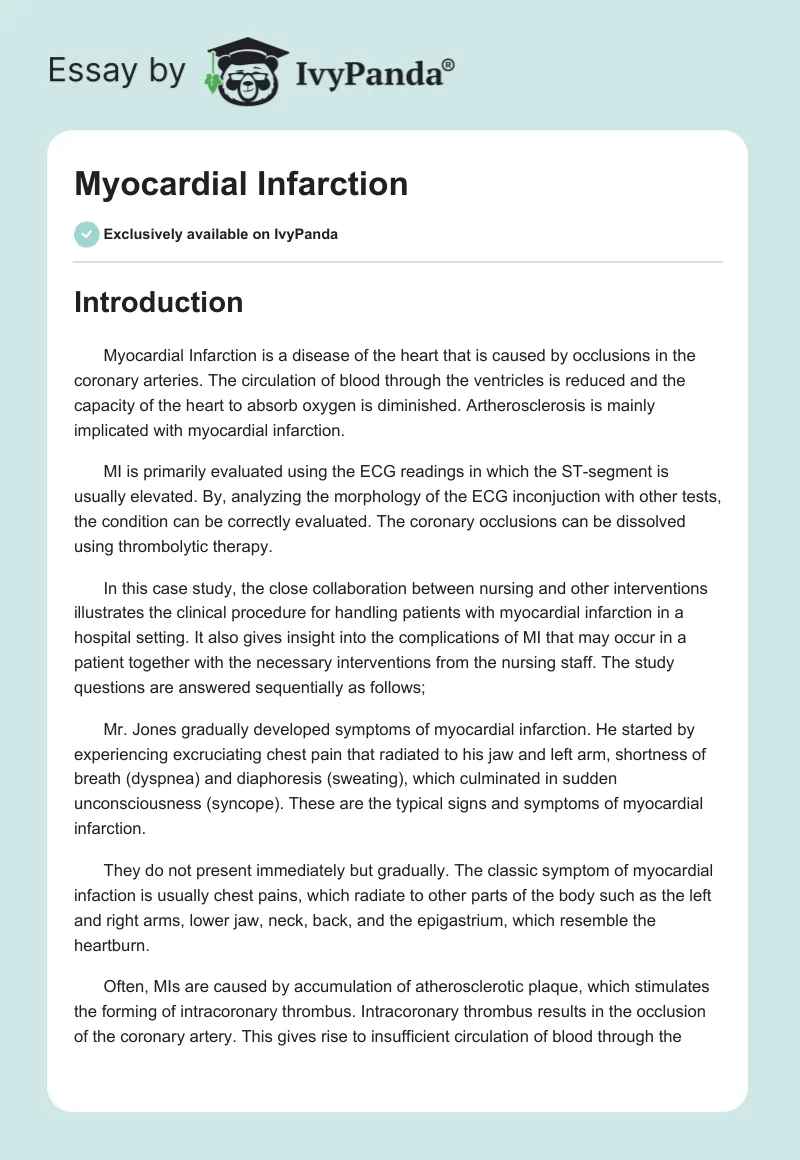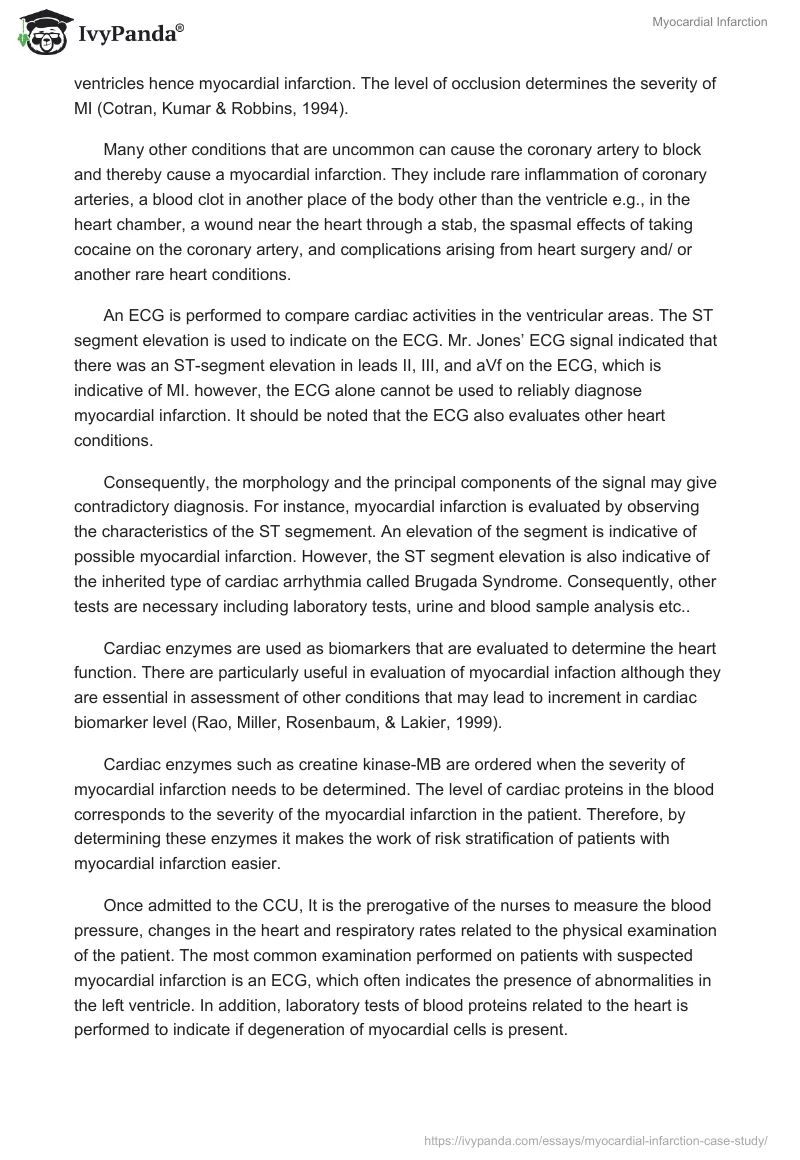Introduction
Myocardial Infarction is a disease of the heart that is caused by occlusions in the coronary arteries. The circulation of blood through the ventricles is reduced and the capacity of the heart to absorb oxygen is diminished. Artherosclerosis is mainly implicated with myocardial infarction.
MI is primarily evaluated using the ECG readings in which the ST-segment is usually elevated. By, analyzing the morphology of the ECG inconjuction with other tests, the condition can be correctly evaluated. The coronary occlusions can be dissolved using thrombolytic therapy.
In this case study, the close collaboration between nursing and other interventions illustrates the clinical procedure for handling patients with myocardial infarction in a hospital setting. It also gives insight into the complications of MI that may occur in a patient together with the necessary interventions from the nursing staff. The study questions are answered sequentially as follows;
Mr. Jones gradually developed symptoms of myocardial infarction. He started by experiencing excruciating chest pain that radiated to his jaw and left arm, shortness of breath (dyspnea) and diaphoresis (sweating), which culminated in sudden unconsciousness (syncope). These are the typical signs and symptoms of myocardial infarction.
They do not present immediately but gradually. The classic symptom of myocardial infaction is usually chest pains, which radiate to other parts of the body such as the left and right arms, lower jaw, neck, back, and the epigastrium, which resemble the heartburn.
Often, MIs are caused by accumulation of atherosclerotic plaque, which stimulates the forming of intracoronary thrombus. Intracoronary thrombus results in the occlusion of the coronary artery. This gives rise to insufficient circulation of blood through the ventricles hence myocardial infarction. The level of occlusion determines the severity of MI (Cotran, Kumar & Robbins, 1994).
Many other conditions that are uncommon can cause the coronary artery to block and thereby cause a myocardial infarction. They include rare inflammation of coronary arteries, a blood clot in another place of the body other than the ventricle e.g., in the heart chamber, a wound near the heart through a stab, the spasmal effects of taking cocaine on the coronary artery, and complications arising from heart surgery and/ or another rare heart conditions.
An ECG is performed to compare cardiac activities in the ventricular areas. The ST segment elevation is used to indicate on the ECG. Mr. Jones’ ECG signal indicated that there was an ST-segment elevation in leads II, III, and aVf on the ECG, which is indicative of MI. however, the ECG alone cannot be used to reliably diagnose myocardial infarction. It should be noted that the ECG also evaluates other heart conditions.
Consequently, the morphology and the principal components of the signal may give contradictory diagnosis. For instance, myocardial infarction is evaluated by observing the characteristics of the ST segmement. An elevation of the segment is indicative of possible myocardial infarction. However, the ST segment elevation is also indicative of the inherited type of cardiac arrhythmia called Brugada Syndrome. Consequently, other tests are necessary including laboratory tests, urine and blood sample analysis etc..
Cardiac enzymes are used as biomarkers that are evaluated to determine the heart function. There are particularly useful in evaluation of myocardial infaction although they are essential in assessment of other conditions that may lead to increment in cardiac biomarker level (Rao, Miller, Rosenbaum, & Lakier, 1999).
Cardiac enzymes such as creatine kinase-MB are ordered when the severity of myocardial infarction needs to be determined. The level of cardiac proteins in the blood corresponds to the severity of the myocardial infarction in the patient. Therefore, by determining these enzymes it makes the work of risk stratification of patients with myocardial infarction easier.
Once admitted to the CCU, It is the prerogative of the nurses to measure the blood pressure, changes in the heart and respiratory rates related to the physical examination of the patient. The most common examination performed on patients with suspected myocardial infarction is an ECG, which often indicates the presence of abnormalities in the left ventricle. In addition, laboratory tests of blood proteins related to the heart is performed to indicate if degeneration of myocardial cells is present.
MI results in diminished supply of oxygen to the heart due to the degeneration of cardiac cells. Consequently, the capacity of the heart to extract oxygen from blood may be compromised. The significance of using oxygen to make sure that the red blood cells are saturated maximally to compensate for the heart’s diminished ability to extract the oxygen.
Mr. Jones’ oxygen demands clearly outstripped supply oxygen dosage ameliorated the situation before comprehensive diagnosis and treatment ensued (Cotran, Kumar & Robbins, 1994). Administration of oxygen supplements treatment of patients with MI. Mr. Jones had shortness of breath and an episode of syncope. As treatment ensued, his oxygen supply had to be stabilized through administration of supplemental oxygen.
Myocardial infarction may give rise to other cardiac conditions that may need proper medical attention. Such conditions include the Wenckebach (Type 1) and Type 2 disarrhythmias. Wenckebach or Type I block is an intermittent cardiac conduction failure. In Wenckeback, conduction reduces as conduction velocity progressively reduces until failure of cardiac electrical conduction occurs. The ECG pattern of the condition shows the PR interval getting progressively longer until the non-conducted wave occurs.
Thrombolytic therapy initiates cardiac hemorrhage in patients with myocardial infaction. It is initiated to dissolve the coronary clots thereby easing the flow of blood and supply of oxygen to the heart. However, this therapy is not suitable in certain conditions such as recent surgery, stroke in the recent past, high blood pressure e.t.c.
The thrombolytic drugs are known to cause hemorrhage elsewhere in the body that can be life threatening in scenarios where a patient underwent surgery recently or is hypertension is present. In the case of Mr. Jones, he became unconscious as soon as he arrived at the reception. In addition, he had very high pressure at 130/92, which made it inappropriate to initiate thrombolytic therapy (Marcus, et al, 2007).
Myocardial infarction is associated with complications such as angina, free wall rupture, reinfarction, extension of infarct, heart failure, aneurysms, cardiogenic shock, valve dysfunction, arrhythmias, central nervous system (CNS) or peripheral embolisation, pericarditis, and psychosocial complications. Mr. Jones developed arrhythmias which were corrected by administration of drugs.
The ECG is the common procedure for diagnosis of myocardial infarctions. However, other diagnostic tests can be carried out on Mr. Jones. They include blood and urine tests, swabs, diagnostic and lab tests, and pathology testing. Pathology testing is important as myocardial infarction could have been caused by a certain underlying pathogen. These tests are performed in order to confirm presence of myocardial infarction because an ECG cannot provide a comprehensive assessment of the condition.
References
Cotran R., Kumar V. & Robbins S. (1994). Robbins Pathologic Basis of Disease. 5th Ed. Philadelphia, PL: WB Saunders Press.
Marcus, et al. (2007). The utility of gestures in patients with chest discomfort American Journal of Medicine, 120(1), 83–9.
Rao P., Miller S., Rosenbaum R., & Lakier J. (1999). Cardiac troponin I and cardiac enzymes after electrophysiologic studies, ablations, and defibrillator implantations. American Journal of Cardiology, 84(4), 470.


